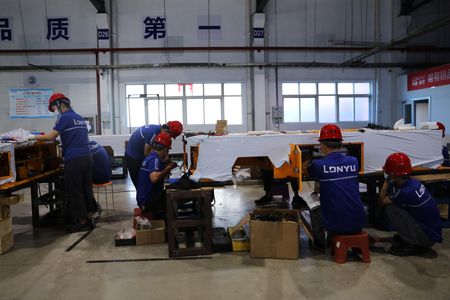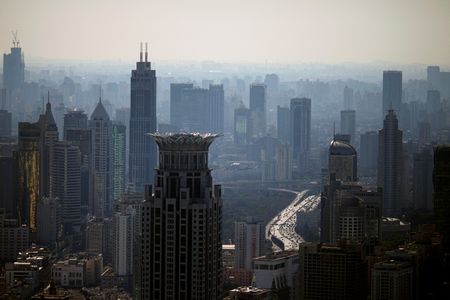By Lucia Mutikani and Jonathan Cable
WASHINGTON/LONDON (Reuters) -Global factory output fell widely last month with U.S. manufacturing activity contracting for the first time in 2-1/2 years and the impact of China’s COVID-19 lockdowns weighing, although the downturn eased in Europe, surveys showed on Thursday.
There were also encouraging signs that inflation may have peaked, or be close to doing so, in many economies as global demand ebbs, although steep price rises and increased borrowing costs as central banks tighten policy aggressively have left indebted consumers feeling the pinch and forcing them to cut spending.
“Global consumers are reining back on spending on discretionary goods in a world of stagflation,” said Duncan Wrigley at Pantheon Macroeconomics.
In the world’s largest economy, U.S. manufacturing activity contracted for the first time in 2-1/2 years in November as higher borrowing costs weighed on demand for goods, but a measure of prices paid by factories for inputs fell for a second straight month, supporting views that inflation could continue trending lower.
The Institute for Supply Management (ISM) said its manufacturing PMI fell to 49.0 last month, under the 50 level that marks growth in activity. That was the first contraction and also the weakest reading since May 2020, when the economy was reeling from the initial wave of COVID-19 infections, and followed 50.2 in October.
The Federal Reserve is in the midst of what has become the fastest rate-hiking cycle since the early 1980s, as it battles inflation, raising the risks of a recession next year.
Fed Chair Jerome Powell said on Wednesday the U.S. central bank could scale back the pace of its rate increases “as soon as December.” The Fed has raised its policy rate by 375 basis points this year from near zero to a 3.75%-4.00% range.
Elsewhere, while the surveys indicated that factories in the euro zone still face a harsh winter it may not be as bad as initially feared and there were indications rampant inflationary pressures were abating.
S&P Global’s final manufacturing Purchasing Managers’ Index (PMI) for the euro zone rose to 47.1 from October’s 46.4, but was below a preliminary reading of 47.3.
An index measuring output, which feeds into a composite PMI due on Monday and seen as a good guide to economic health, rose to 46.0 from 43.8, marking its sixth month of sub-50 readings.
“Today’s PMI data corroborate our view that manufacturing is headed for a winter recession but suggest the outlook for the sector is starting to improve slightly,” said Riccardo Marcelli Fabiani at Oxford Economics. Economists in a recent Reuters poll gave a 78% chance of a recession within a year.
However, both the input and output prices indexes dropped substantially, likely welcome news to policymakers at the European Central Bank.
In Britain, outside the European Union, manufacturing activity fell for a fourth month in a row, as businesses faced the weakest overseas demand in 2-1/2 years, leading to job cuts and reduced confidence about the year ahead, its PMI showed.
The figures added to signs Britain’s economy has fallen into recession, although there was a glimmer of light there too for the Bank of England as factory output price inflation slowed to its lowest since March 2021.
ASIAN WOES
The results highlighted Asia’s darkening economic outlook for 2023, as China’s lockdowns disrupt international supply and heighten fears of a further slump in its economy, the world’s second-largest.
Those lockdowns have hit production and stoked rare street protests across many cities in China.
Amid the pandemic curbs, Chinese factory activity shrank in November, a private survey showed. The result implied weaker employment and economic growth in the fourth quarter.
China’s Caixin/S&P Global manufacturing PMI stood at 49.4 in November, up from 49.2 in the previous month. It has been below 50 for four consecutive months.
The figure followed downbeat data in an official survey on Wednesday that showed manufacturing activity had hit a seven-month low in November.
Analysts see mounting downside risks to China’s economic growth in the fourth quarter, despite a flurry of policies to shore up activity, including cuts to banks’ required reserve ratios and support for the sluggish property sector.
The impact of China’s woes was felt widely across Asia. Taiwan’s PMI stood at 41.6 in November and Vietnam’s PMI fell to 47.4. Indonesia’s slid to 50.3 from 51.8.
Manufacturing activity also contracted in export-reliant economies, including Japan and South Korea, and in emerging nations, such as Vietnam, underscoring widening damage from weak global demand and stubbornly high input costs, surveys showed.
Japan’s au Jibun Bank PMI also fell, to 49.0 in November from 50.7, its first contraction since November 2020.
South Korea’s factory activity shrank for a fifth straight month but the downturn moderated slightly, possibly suggesting the worst was over for businesses there.
However, South Korea’s exports in November suffered their steepest annual drop in 2-1/2 years, separate data showed, hit by cooling global demand in major markets led by China and a downturn in the semiconductor industry.
In a rare bright sign, India saw factory activity expand in November at its fastest pace in three months, thanks to robust demand for consumer goods and a slowdown in input-cost inflation.
(Reporting by Lucia Mutikani, Jonathan Cable and Leika Kihara; Writing by Lindsay Dunsmuir; Editing by Bradley Perrett, Susan Fenton and Andrea Ricci)


